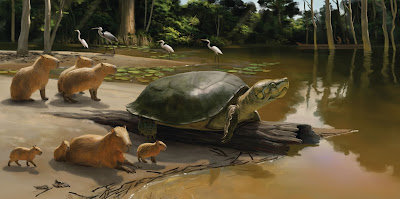 |
| Peltocephalus maturin Ferreira, Nascimento, Cadena, Cozzuol, Farina, Pacheco, Rizzutto & Langer, 2024 artwork by Júlia d'Oliveira |
Abstract
Overkill of large mammals is recognized as a key driver of Pleistocene megafaunal extinctions in the Americas and Australia. While this phenomenon primarily affected mega-mammals, its impact on large Quaternary reptiles has been debated. Freshwater turtles, due to the scarcity of giant forms in the Quaternary record, have been largely neglected in such discussions. Here we present a new giant podocnemidid turtle, Peltocephalus maturin sp. nov., from the Late Pleistocene Rio Madeira Formation in the Brazilian Amazon, that challenges this assumption. Morphological and phylogenetic analyses of the holotype, a massive partial lower jaw, reveal close affinities to extant Amazonian species and suggest an omnivorous diet. Body size regressions indicate Pe. maturin possibly reached about 180 cm in carapace length and is among the largest freshwater turtles ever found. This finding presents the latest known occurrence of giant freshwater turtles, hinting at coexistence with early human inhabitants in the Amazon.
Systematic palaeontology
Testudines Batsch, 1788
Pleurodira Cope, 1864
Podocnemididae Cope, 1868
Peltocephalus Dumeril and Bribon, 1835
Peltocephalus maturin sp. nov.
Diagnosis: Peltocephalus maturin is assigned to Pelomedusoides based on its fused dentaries and to Peltocephalus by the symphyseal hook higher than the coronoid process, the lingual platform and a small fossa with two pits on the posterior surface of the symphysis. It differs from Podocnemis spp. in its straight, instead of curved, labial and lingual ridges, U-shaped midline outline of the lingual ridges, well-developed symphyseal hook, transverse posterior (lingual) platform ventral to the triturating surface and the symphyseal fossa; from Erymnochelys madagascariensis by two pits in the symphyseal fossa, instead of one; from both Podocnemis spp. and E. madagascariensis in its dorsoventrally—instead of posteroventrally—sloping posterior limit of the rhamphotheca. Peltocephalus maturin can be distinguished from Pe. dumerilianus based on its much greater size, labial ridge higher than the lingual, symphyseal ridge separating left and right triturating surfaces (all these shared with Stupendemys geographica), and secondary ridge orthogonal to the long axis of the triturating surface, separating anterior and posterior triturating areas (autapomorphy). Peltocephalus maturin can be differentiated from S. geographica by narrow instead of expanded triturating surfaces, upcurved pointed symphyseal hook and sharp but not protruding and anteriorly V-shaped lingual ridges, instead of protruding and U-shaped.
Etymology: Maturin refers to the giant turtle that vomited out the universe in Stephen King's stories, which in turn was inspired by the character Stephen Maturin who, in the book H.M.S. Surprise of Patrick O'Brian's Aubrey-Maturin series, names a giant tortoise.
G. S. Ferreira, E. R. Nascimento, E. A. Cadena, M. A. Cozzuol, B. M. Farina, M. L. A. F. Pacheco, M. A. Rizzutto and M. C. Langer. 2024. The Latest Freshwater Giants: A New Peltocephalus (Pleurodira: Podocnemididae) Turtle from the Late Pleistocene of the Brazilian Amazon. Biol. Lett. 2020240010. DOI: 10.1098/rsbl.2024.0010


